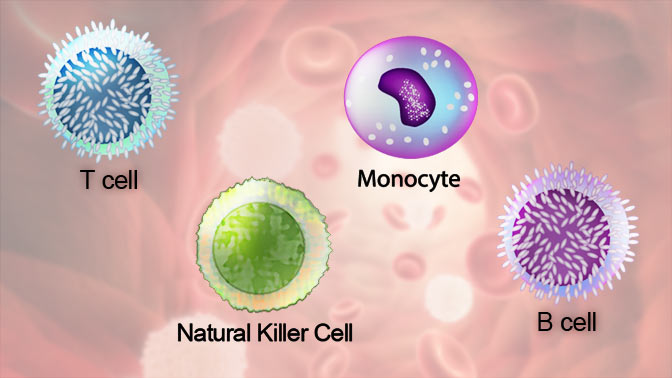Home page Description:
Gene linked to spinal arthritis sits at the crossroad between cellular stress and inflammation.
Posted On: March 29, 2017

Image Caption:
Certain immune cells, known as mononuclear cells (a selection of which are pictured), accumulate at the site of persistent inflammation.
Too much of a good thing can be harmful.
This definitely holds true when it comes to the immune system. As the body’s primary weapon against bacterial and viral intruders, the immune system is vital for maintaining health. But an overactive immune response can also be detrimental and can lead to a prolonged immune response (ie, chronic inflammation) that can damage healthy tissue.
When the immune system attacks the joints of the spine, spinal arthritis can result. Also known as ankylosing spondylitis (AS), this condition can cause the spine’s vertebrae to fuse. While there are medications that can slow disease progression or offer pain relief, there is currently no cure for AS. Moreover, the exact causes of the disease remain a mystery.
However, it is known that genetics—the genes that you inherit from your parents—play a key role in AS. In total, over 60 genes have been linked to the disease.
Recent findings from Krembil Scientist Dr. Nigil Haroon reveal that the function of a gene, known as endoplasmic reticulum aminopeptidase 2 (ERAP-2), is abnormal in individuals with AS. Now his research team is digging deeper into how exactly abnormal ERAP-2 function may contribute to disease.
The researchers used experimental models and patient immune cells, known as peripheral mononuclear cells, to explore the role of ERAP-2 in AS. “When ERAP-2 was missing or decreased, we saw increased levels of particular immune proteins, known as MHC-I free heavy chains, that are associated with disease risk. This is particularly relevant because one type of MHC-I free heavy chain molecule—known as HLA-B27–is found in 80-90% of AS patients. We also saw increased levels of cellular stress known as the unfolded protein response. And it is known that overstimulation of this response can lead to chronic inflammation—a key factor in the development of ankylosing spondylitis,” says Dr. Haroon.
By uncovering the role of this gene in AS, Dr. Haroon has laid a foundation for the design and identification of new curative treatments that could one day address the underlying causes of this disease.
This work was supported by the Arthritis Society, the Arthritis Research Foundation, the Canadian Institutes of Health Research and the Toronto General & Western Hospital Foundation.
Zhang Z, Ciccia F, Zeng F, Guggino G, Yee K, Abdullah H, Silverberg MS, Alessandro R, Triolo G, Haroon N. Functional interaction of ERAP2 and HLA-B27 activates the unfolded protein response. Arthritis Rheumatol. 2016 Dec 28. doi:10.1002/art.40033.
This definitely holds true when it comes to the immune system. As the body’s primary weapon against bacterial and viral intruders, the immune system is vital for maintaining health. But an overactive immune response can also be detrimental and can lead to a prolonged immune response (ie, chronic inflammation) that can damage healthy tissue.
When the immune system attacks the joints of the spine, spinal arthritis can result. Also known as ankylosing spondylitis (AS), this condition can cause the spine’s vertebrae to fuse. While there are medications that can slow disease progression or offer pain relief, there is currently no cure for AS. Moreover, the exact causes of the disease remain a mystery.
However, it is known that genetics—the genes that you inherit from your parents—play a key role in AS. In total, over 60 genes have been linked to the disease.
Recent findings from Krembil Scientist Dr. Nigil Haroon reveal that the function of a gene, known as endoplasmic reticulum aminopeptidase 2 (ERAP-2), is abnormal in individuals with AS. Now his research team is digging deeper into how exactly abnormal ERAP-2 function may contribute to disease.
The researchers used experimental models and patient immune cells, known as peripheral mononuclear cells, to explore the role of ERAP-2 in AS. “When ERAP-2 was missing or decreased, we saw increased levels of particular immune proteins, known as MHC-I free heavy chains, that are associated with disease risk. This is particularly relevant because one type of MHC-I free heavy chain molecule—known as HLA-B27–is found in 80-90% of AS patients. We also saw increased levels of cellular stress known as the unfolded protein response. And it is known that overstimulation of this response can lead to chronic inflammation—a key factor in the development of ankylosing spondylitis,” says Dr. Haroon.
By uncovering the role of this gene in AS, Dr. Haroon has laid a foundation for the design and identification of new curative treatments that could one day address the underlying causes of this disease.
This work was supported by the Arthritis Society, the Arthritis Research Foundation, the Canadian Institutes of Health Research and the Toronto General & Western Hospital Foundation.
Zhang Z, Ciccia F, Zeng F, Guggino G, Yee K, Abdullah H, Silverberg MS, Alessandro R, Triolo G, Haroon N. Functional interaction of ERAP2 and HLA-B27 activates the unfolded protein response. Arthritis Rheumatol. 2016 Dec 28. doi:10.1002/art.40033.




